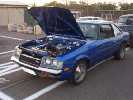| Author | Topic |
|---|
Location:
Melb
Registered:
June 2004
|
|
RA28- 18rg ignition questions.
|
 Fri, 10 September 2004 05:35
Fri, 10 September 2004 05:35

|
 |
Well, have been slowly but surely getting a heap of jobs done on the new ra28. It has an 18rgu (converted back to twin solex carbs) at the moment which im just using basically to mave the car around etc until i get it up to a level where i can put the 1g-gte in.
Anyway, the engine is hard to start and is not running particularly well. Huge flat spot and not a really strong spark.
Have been looking over the wiring cos the previous owner has done some interesting things to the ignition. For example, two kill switches that light up! Its kind of like really tacky and cheap 'poor mans rice' mods.
I am noticing that the positive side of the coil is not getting 12v. In fact its only about 5v. On the odd occasion the positive side is getting 12v. There is a rectangle unit that sits on the coil with what seems like an element in it that is getting 12v at both sides.
The negative side of the coil is reading 12v also.
The Wiring looks correct at the coil level, however something seems a little suss. Iam also not to confident about the quality and life of the batt.
Any thoughts would be appreciated.
Should the neg side be getting 12v? What is the unit mounted on the coil designed to do?
Sorry about long post.
Thanks Tom
|
|
|
Location:
Brisbane
Registered:
June 2004
|
|
Re: RA28- 18rg ignition questions.
|
 Fri, 10 September 2004 05:59
Fri, 10 September 2004 05:59
 
|
 |
Tom,
The rectangular unit on the coil with the element in it is the starting resistor. They are notorious for breaking down. They are however relatively cheap to replace.
The coil is designed to operate at a voltage less than 12 volts. Ususally 9-10V. The resitor drops a couple of volts across it during normal operation, so that the coil gets the required 9-10V. During starting when cranking voltage can be less than 12 volts, the resistor is shorted out by the ignition keyswitch in the start position. This gives full battery voltage under cranking conditions to the coil.
Temporarily short ot the resistor and take the car for a run. If that fixes your problems, then replace the resistor.
Hope that helps. Good luck !
|
|
|

Location:
townsville NQLD
Registered:
February 2004
|
|
Re: RA28- 18rg ignition questions.
|
 Sat, 11 September 2004 10:48
Sat, 11 September 2004 10:48
 
|
 |
| Quote: |
Temporarily short ot the resistor and take the car for a run. If that fixes your problems, then replace the resistor.
|
i dont think it will be a resistor if it has electronic ignition. if it has elec ign. then that box is a igniter assit box. dunno much about these but when i got my 18r-gu, it had no igniter asssit box with it. luckily i got one out of a cressida of a similar era and used the coil and igniter assist. the plugs didnt match but i put 2 flat blades on em.
positive on coil- gets 12v from ignition switch
negative on coil- gets a negative pulse from the igniter assist, it turns a electric magnetic pulse into a 12v pulse.
|
|
|
Location:
Melbourne
Registered:
October 2003
|
|
Re: RA28- 18rg ignition questions.
|
 Sat, 11 September 2004 12:47
Sat, 11 September 2004 12:47

|
 |
Even if your battery was bad, once running your alternator
would take up the slack. Should read around 13.XV
You would read 12V on the positive side of the coil with the ignition on, even if the resistor is working since no current
will be entering the coil once it's built up a magnetic flux.
Since voltage drop over a resistance is I*R (where R is resistor, I is current). Your voltage drop would be zero.
Once the car is running, and the coil is drawing some current,
say 10amps, any resistances you have in your ignition system
will then have a voltage drop.
I think that those kill switches are 90% of your problem.
If you've got a multimeter disconnect a terminal off your battery
and measure how many ohm's there is across the ballast resistor.
Then measure between the coil positive and battery positive. (with ignition in on position) In theory it should be the same as just the resistor, but if it's a fair bit higher there's your trouble.
voltage drop can occur over old ignition barrel contacts, (kill) switches, dirty contact areas, and bad connections. Eliminte these and you'll probably find your problem solved..
Of course it could be the condensor, points, etc etc...
hope this helps!
[Updated on: Sat, 11 September 2004 12:54]
|
|
|